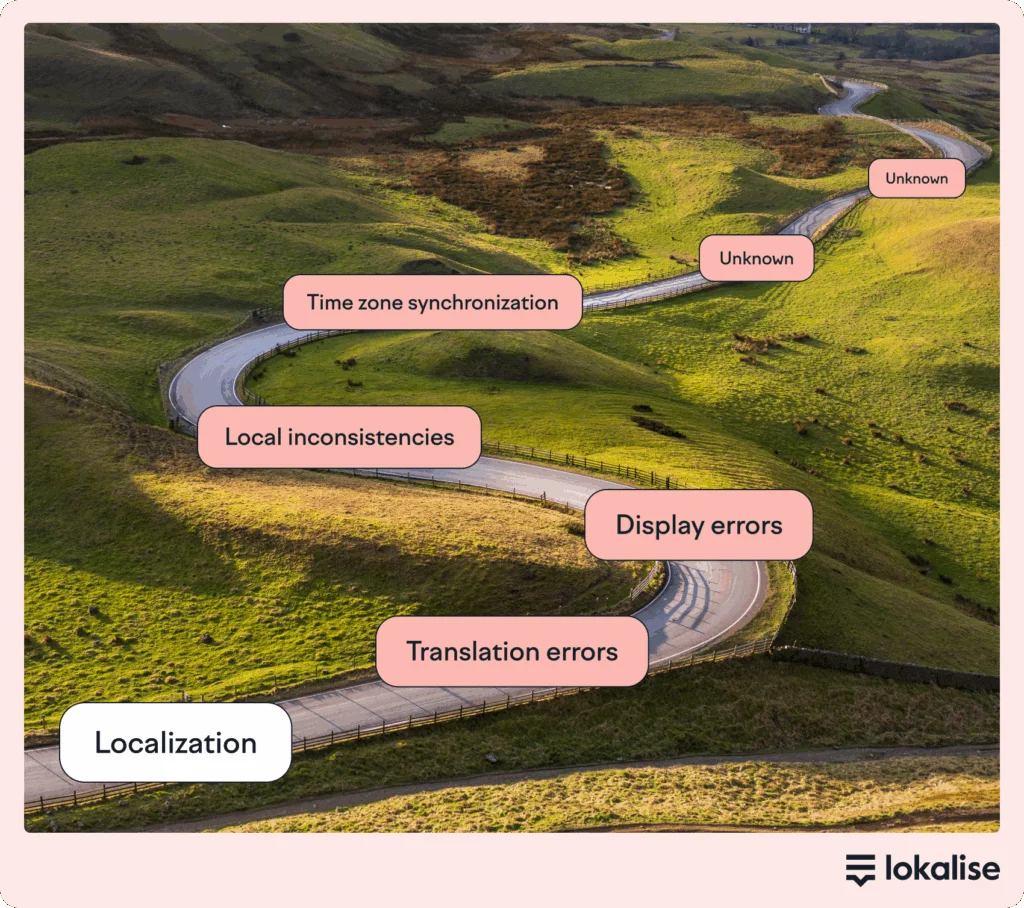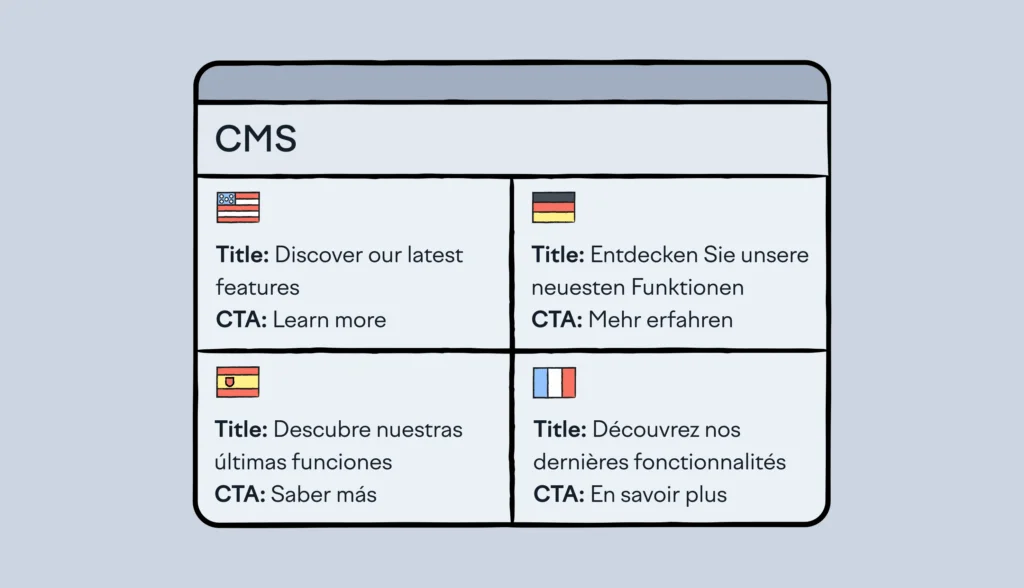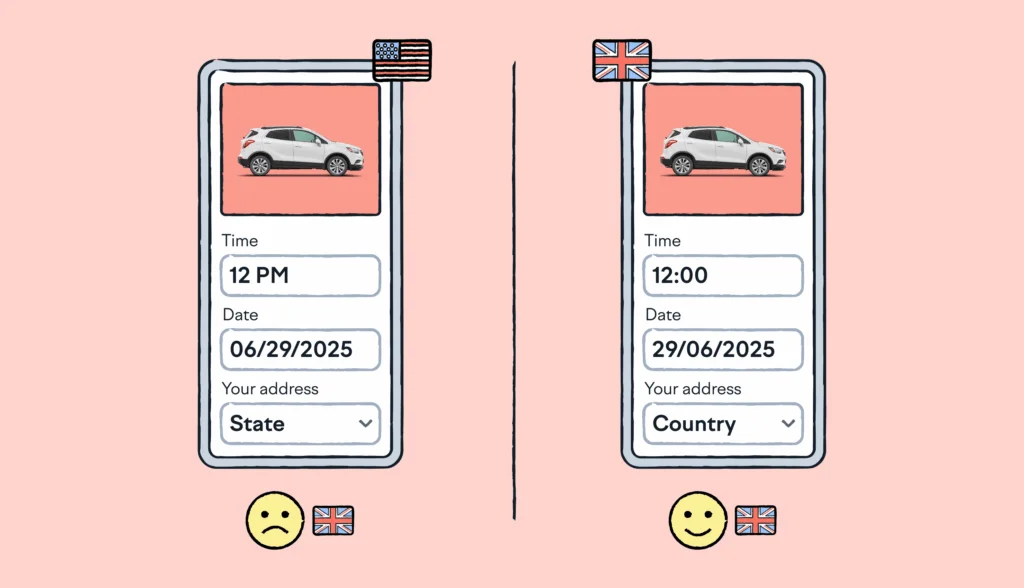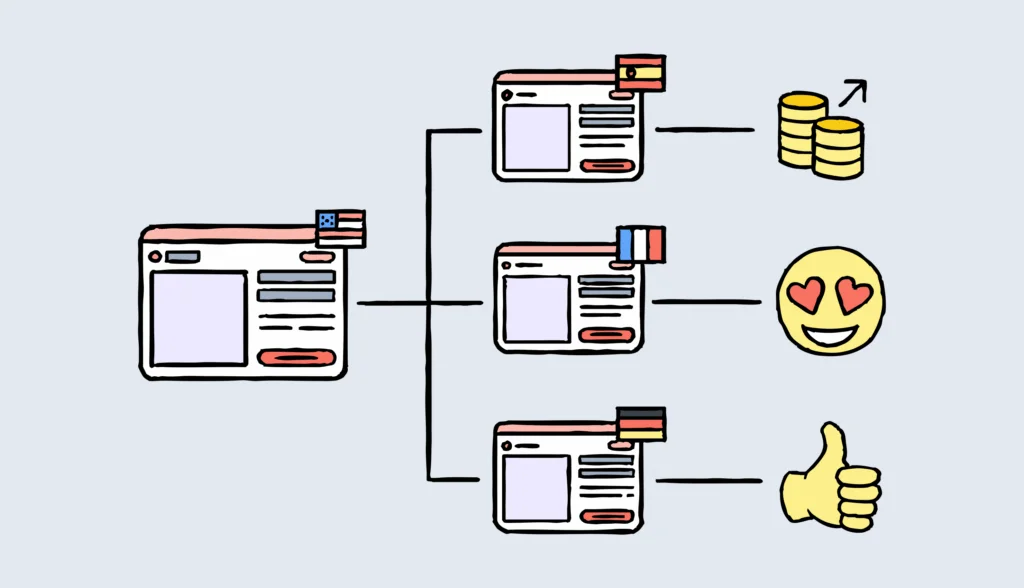Top Things to Know:
- Research shows that 76% of consumers prefer purchasing products in their own language.
- Localization is not limited to bigger businesses exclusively. Broadening your reach into new markets can be done from as early as you like.
- Content Management System (CMS) localization is not only about text! It is also about images, symbols, colors, sounds, public figures… The list goes on.
- CMS localization is not a one-size-fits-all process. You need to explore and find what suits your product best, according to time, budget, priority and availability.
What is CMS Localization?
Content Management System (CMS) localization—also known as CMS internationalization, or CMS translation—consists of configuring your CMS to open your content to different markets. The goal is to localize your content and make it understandable in various regions, through the adaptation of different factors, such as currency, visuals, date formats…
How CMS Localization Benefits Your Business
Higher revenue, boosted visibility, ahead of competitors… These are examples of what happens when your product is expanded to new markets. However, a simple word-for-word translation made on a disorganized spreadsheet by someone whose job is not translation will not work in your favor. Offering content that makes sense to your target audience is non-negotiable when it comes to globalizing your product.
CMS localization is key for various reasons:
- More growth = more revenue: when you reach a wider audience, and you do it well, your chance to increase growth and revenue gets greater.
- You do what the competition does not: having an edge on your competitors helps you stay relevant in the industry and be more visible to potential customers.
- People find you more easily: when your content is localized, your Search Engine Optimization (SEO) is boosted, and you have a better chance to rank higher when people search the type of product you offer.
- Your audience browses smoothly on your website/app: when your product is available in their language, everything feels easy and more intuitive to navigate.
Understanding the power CMS internationalization holds is your key to witnessing better success for your product. When you make your content accessible to more people, they feel seen and are more likely to pick your offer.
🧠Did you know?
Around 6.4 billion people own a smartphone. This is roughly 80% of the worldwide population. Web CMS localization is not your only option. Have you considered investing in the localization of your mobile CMS?
The Must-Do in CMS Localization
When starting off with CMS localization, you might realize that the scope of work is heavier than expected. For this reason, you must be fully aware of the extent of localization and the elements that cannot be overlooked. Take a look at the list below to understand what CMS translation implies:
- Headers, bodies, footers…
- Menus
- SEO Metadata
- Error messages and notifications
- Currencies and measurement units
- Time and date format
- Legal information
- Filters, tags and categories
- Visuals and alt text
- CTAs
- URL and slugs
Of course, this list varies depending on your product. Your potential customers must understand all the information they see for an immersive experience. Moreover, some content cannot be simply translated. For instance, legal regulations are different from one market to another and your audience must have access to the right information.
Setting Up Your Localization-Friendly CMS
Most CMSs are localization friendly. For those that are not, you can simply add a plug-in that will allow the configuration and localization of your content.
Before that, make sure that you are ready to tackle your localization needs. Some elements are to be taken into consideration for a seamless localization project.
Set Up the Interface
Globalizing your product means working with translators, usually native of the target language. To help them work effectively, the CMS interface should be available in their language. A localized interface reduces misunderstandings and miscommunication.
Add a Language Selector on Your Website
When your website is available in multiple languages, your users must be able to easily access this option. Make sure a language selector is available and visible so they can choose their preferred locale.
🧠Pro tips
If you offer different language variants, do not forget to include all of them in your language selector! (Example: Canadian French and French from France.)
Assess Your Localization Scope
Before starting the localization process, you need to define what exactly needs to be localized:
- A specific page
- A selection of services
- The entire website/application
Clarifying the scope improves organization and synchronization and helps coordinate efforts between the different people involved. Inform your project manager about what content needs localization and which languages are required. This avoids wasting time and budget.
Make Your Locales Visible
On your website, the visible content is localized, but you also need to optimize what is not directly visible to your end users.
Localize your URLs – use SEO-friendly structures to reach the right audiences. Structures like subdirectories (/en/, /es/), subdomains (fr.example.com) and country-code TLDs (example.it, example.jp) help your website land in the right place.
Implement hreflang tags – those tags (<link rel=”alternate” hreflang=”…”>) indicate which language each page is in. They help search engines suggest the correct language to users.
Sitemaps generation – an XLM sitemap (a file that lists a website’s main pages) should include all the localized versions available of your website. If supported, you can add hreflang tags to a sitemap. Submit those sitemaps to tools like Google Search Console. This improves factors like crawl efficiency, indexing speed and coverage reporting, helping search engines understand how your localized pages relate to each other.
Which CMS to Go For?
There are two different CMSs you can go for. Both have different purposes that serve various needs. Your available resources, your budget and your goals are the elements that help you pick the most adequate CMS for your organization.
The most popular is a traditional CMS, which:
- Connects the back end (developer side) and front end (what users see).
- Is easy to use because little or no coding is needed to manage content.
- Limits your possibility to share content across multiple devices.
- Requires you to use different platforms for each device as your business grows.
Some of the best traditional CMSs on the market are WordPress, Magento and Joomla, all following a traditional architecture.
The other option is a headless CMS, a more technical approach that:
- Is more complex, but more flexible.
- Allows you to get your content delivered via an Application Programming Interface (API) to any device.
- Developers choose to have more freedom as they can use their preferred programming languages.
Some of the best headless CMSs on the market are Strapi, Ghost and Directus, leaders of the API driven CMS approach.
Knowing which path to take and understanding exactly what you need is essential to choosing the CMS that fits your requirements best. Communicate with your teams to set clear goals and KPIs before starting the localization part of the process.
Hidden Roadblocks and Challenges in CMS Localization
Localization is a complex process, and you must be prepared for challenges you encounter along the way. While the difficulties you face are specific to your product and the markets you want to target, some factors are always applicable in CMS internationalization:
Translation errors – automated translation can lead to incorrect or confusing translations on your website. To avoid this, always have a team of professional translators review the pre-translated content. Human review helps prevent confusion with your target audience.
Display issues – localization affects how content appears online. Character limits must be taken into account by your localization team to avoid formatting problems. If not managed properly, display issues can damage your brand image and the user experience.
Inconsistency in local specificities – local details matter for effective CMS translation. Double-check information such as currencies, time formats, country-specific regulations. Ensuring accuracy helps your audience feel more familiar and trustful with your product.
Localization synchronization – teams working across time zones face coordination challenges. For example, a New York-based team may publish content when Japan-based translators are unavailable. To avoid delays, schedule your localization workflow in advance and communicate early with your localization team to handle time differences smoothly.
You will most likely encounter new hidden roadblocks as your first rounds of localization go live. It is important for your localization team to spot those inconsistencies, get feedback, and improve from there. That way, your CMS localization process gets smoother as time goes on.

Pick Your Process: Manual, Automated, or Integrated?
There are three types of CMS localization. The one you choose depends on your needs, your timeline, your budget and your scope of work. Every process has its pros and cons, and you should know what to expect when picking one over the other to avoid surprises along the way.
| Process | What | Pros | Cons |
| Manual | Copy/paste from external files | Full control over the contentLower budget | Time consumingMore prone to display issues |
| Automated | Automatic translation via machine translation (MT) | Content available immediatelyLowest budget | More prone to contextual errors |
| Integrated | CMS linked to a localization content management system | More professional (use of glossaries, Translation Memories (TM), etc.)Full control on the content | More organizationHigher budget |
By definition, an integrated CMS localization is the recommended option. It is more professional, it goes more in-depth, you have more control over the content that goes live for each market… However, greater quality has a higher price tag, and requires rock-solid localization tactics to succeed.
💡Remember!
There is no right or wrong answer regarding which CMS translation process you should go for. Automated might not work for very niche and technical content, but it can be an effective choice for simple text and short notifications. You can mix and match the different processes and adjust after you gather a first set of feedback!
Keeping Translations Up to Date
As you develop your product, more content goes live on your website/app. This content will not necessarily be available in all the languages your product is opened to as soon as it comes out. For this reason, keeping your translations up to date is mandatory for your credibility as well as your visibility online.
- Stay on top of your content – continuous localization, a subset of agile localization, consists of breaking new code into smaller batches that are constantly sent for localization to avoid delays in the availability of content throughout the markets.
- With automated CMS localization – check that the new localizations are correct. While untranslated keys have a negative impact on your user experience, mistranslated keys are equally harmful. Your localization team must make sure that all the automatic translations are correct in context, and edit them if needed.
- Plan new rounds of localization –synchronize your development team and your localization team to let each other know when new content and its localization are available. Some CMSs automatically inform the right stakeholders. Otherwise, it is the role of your project managers to be the middlemen between the different actors involved in localization.
- Keep your space clean and organized – some translations become outdated because your translation team adjusts their work as time goes on. Those unused strings take space, both in your CMS storage and your organization. Get rid of what is no longer needed to keep useful files and avoid confusion between your teams.
How Different Are CMS Localization and Website Localization?
CMS localization and website localization are often used interchangeably. However, there is a slight difference between the two processes. In the grand scheme of things, both involve adapting your product for local markets. On a smaller scale, CMS localization is the tool that helps you localize your website. The table below shows the main differences between them. Keep in mind that every business has different needs, so each process varies:
| Elements | CMS Localization | Website Localization |
| Definition | Configuration of a CMS for localization | Language adaptation of website content |
| Target | Businesses | End users |
| Goal | Enabling a strong and centralized organization for localization | Making your product available for different markets |
| Example | Managing localization through the CMS | Localized content live on the website |
The main difference between the two processes is who is using what. While CMS localization is designed for your teams to set their localization strategies (back end), website localization is what your target audiences interact with (front end).
👀 See it that way…
Website localization is the cake you want to bake. CMS localization is the set of utensils you use to bake. Finally, localization strategy is the recipe you follow to ensure everybody enjoys your cake!
Localization at the Core of Your Content Strategy
Reaching new audiences is a good way to gain visibility and credibility globally. When your content is relevant for different markets, your potential customers are more likely to trust your product and choose you over competitors. However, reaching your new audiences is not just about translation. Localization goes beyond changing a word into its equivalent in other languages.
Making localization a core part of your content strategy goes a long way: cultural nuances, right tone of voice, adapted visuals, country-specific SEO… You must consider a long list of factors that differentiate a good localized product from an outstanding one.
A bulletproof localization strategy depends on the expertise of your team: your project managers need to prioritize, organize and synchronize the content to be localized seamlessly. Your professional translators, in-house or not, must be up-to-date with the subtleties of their language and their target market. Your CMS developers must provide clear guidelines and feedback on technical factors such as character limitation, URL localization and string formatting to ensure smooth integration of the localized content.
When taken seriously, localization can be a gold mine for the growth of your product. Speaking the language of your customers is the best way to build trust with them and create loyalty.
Localization CMS—One Aspect of Your SEO Strategy
A good localization CMS is SEO-friendly. You want to expand your product to new markets in order to get more visibility worldwide and generate more growth. Working on a localization-friendly CMS must help you with multilingual SEO to boost your ranking in your niche. Look for software that allows you to have control over a selection of the following elements for each language:
- Metadata
- Tags
- Sitemaps
- Local search behaviors
- URLs
No matter what language your customers use to search for the service you offer, they should land on localized content that resonates with them. Over time, increasing your ranking increases your revenue, too.





